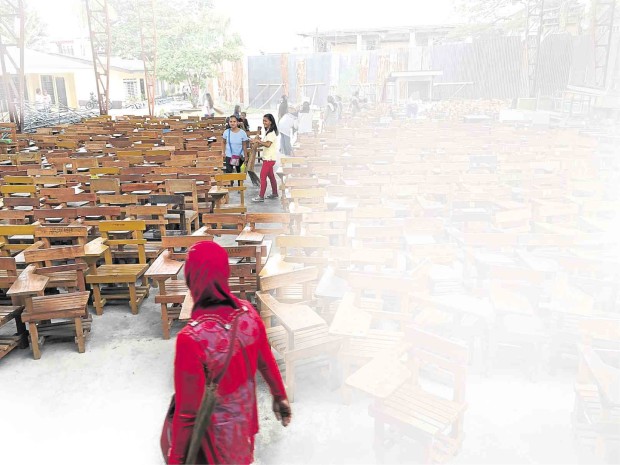
ARMCHAIRS for use by students at Santa Barbara Elementary School in Zamboanga City are arranged in the school’s covered court, which would be used as makeshift classrooms at the start of classes this month. JULIE S. ALIPALA/INQUIRER MINDANAO
ZAMBOANGA CITY—MORE than 3,000 students here will return to their war-ravaged schools when classes open next week.
Pedro Melchor Natividad, the division school superintendent, said five schools damaged by the siege in 2013 would open for the new school year.
Since 2013, students from these schools have virtually become “squatters,” holding classes in other schools or in makeshift tents.
“We are now opening the doors of these schools. No more squatting. The makeshift tents have already been removed,” Natividad said.
At least 13,000 students from five schools—Mariki Elementary School, Rio Hondo Elementary School, Santa Barbara Elementary School, Don Gems Elementary School and Talon-Talon Elementary School—have been displaced since 2013. They held classes in open spaces and classrooms in other schools.
Daisy Ebrada, principal of Santa Barbara Elementary School, said buildings in the school were “riddled with bullets and hit by bombs.”
“Roofs, walls and ceilings are covered with holes,” she said.
But Ebrada said the school had to “move on” and use the classrooms “even without the necessary repair and rehabilitation.”
Ebrada said repair work had been slow and incomplete three years after the siege.
The Department of Public Works and Highways has yet to complete a three-story building that was supposed to be ready by June 13.
“I am not an engineer, but from the looks of it, I doubt if we can use the new building this year,” Ebrada said.
Natividad said the delay was caused by the tedious “processes.”
“We asked the city engineer’s office for an assessment. Then we went to Manila to submit the request for approval. Then we submitted the request to the President (Aquino), but the papers [remained] in his office [for a while] before he approved the assessment for budget allocation,” Natividad said.
Natividad said when the budget was released, the DPWH “realized there was no assessment and budget for demolition.”
“I think these were the reasons why construction was delayed,” he said.
But there were was also some good news. More than 2,000 students of Santa Barbara would be using 22 repaired classrooms.
Radzma Saham, 32, said she was happy that her daughter was returning to school in Santa Barbara.
“It will be a big saving for us,” she said.
Saham said her daughter had to take two rides to go to East Central School after the siege displaced students in Santa Barbara.
“Her pocket money is just enough for fare, so she has to skip snacks,” Saham said.
Mayor Maria Isabelle Salazar said she expected all five schools to resume normal operations when classes started.
She admitted, though, that at least two schools were still occupied by evacuees.